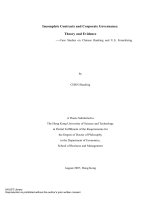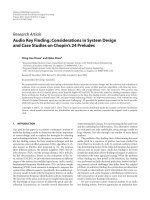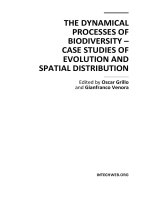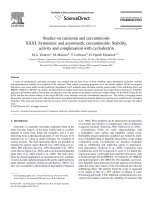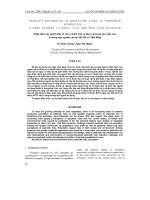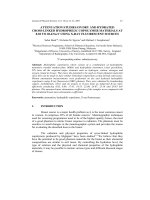Interactive avatar control case studies on physics and performance based character animation
Bạn đang xem bản rút gọn của tài liệu. Xem và tải ngay bản đầy đủ của tài liệu tại đây (8.35 MB, 75 trang )
INTERACTIVE AVATAR CONTROL: CASE
STUDIES ON PHYSICS AND PERFORMANCE
BASED CHARACTER ANIMATION
STEVIE GIOVANNI
(B.Sc. Hons.)
A THESIS SUBMITTED
FOR THE DEGREE OF MASTER OF SCIENCE
DEPARTMENT OF COMPUTER SCIENCE
NATIONAL UNIVERSITY OF SINGAPORE
2013
DECLARATION
I hereby declare that this thesis is my original
work and it has been written by me in its entirety.
I have duly acknowledged all the sources of
information which have been used in the thesis.
This thesis has also not been submitted for any
degree in any university previously.
Stevie Giovanni
3 January 2013
i
ACKNOWLEDGMENTS
I would like to take this chance to express my sincere gratitude to my supervisor, Dr. KangKang Yin, for her patience and guidance on this report. She has given
good advices in terms of the structures and technical content of the paper. She has
also greatly inspired me on my research topic and helped me on the preliminary
work by giving me the chance to work with her and getting more familiar with the
field. Without her efforts, I would not have been able to complete the work in this
report.
Also, I would like to thank my family, especially my mother, for all the support
they have given me throughout my master’s studies. They encouraged me to keep
moving forward during my ups and downs, and their constant faith in me will forever
be my motivation to face the hardships I might encounter in the future.
And finally, I would like to give special thanks to Terence Pettit for being a
very good friend and for the time he dedicated to help me proofread this report.
ii
TABLE OF CONTENTS
Acknowledgments . . . . . . . . . . . . . . . . . . . . . . . . . . . . . . . . .
ii
Summary . . . . . . . . . . . . . . . . . . . . . . . . . . . . . . . . . . . . .
v
List of Tables . . . . . . . . . . . . . . . . . . . . . . . . . . . . . . . . . . .
vi
List of Figures . . . . . . . . . . . . . . . . . . . . . . . . . . . . . . . . . .
viii
1 Introduction . . . . . . . . . . . . . . . . . . . . . . . . . . . . . . . . . .
1
2 Literature Review . . . . . . . . . . . . . . . . . . . . . . . . . . . . . . .
3
2.1
Kinematic Character Animation . . . . . . . . . . . . . . . . . . . .
3
2.1.1
Inverse Kinematics . . . . . . . . . . . . . . . . . . . . . . .
5
Data-Driven Character Animation . . . . . . . . . . . . . . . . . . .
7
2.2.1
Motion Capture . . . . . . . . . . . . . . . . . . . . . . . . .
8
2.2.2
Applications of Data-Driven Animation . . . . . . . . . . . .
9
Physics-Based Character Animation and Control . . . . . . . . . . .
11
2.3.1
Forward and Inverse Dynamics . . . . . . . . . . . . . . . .
12
2.3.2
Physics-Based Controller Modeling . . . . . . . . . . . . . .
13
2.3.3
Control Algorithms . . . . . . . . . . . . . . . . . . . . . . .
18
2.3.4
Controller Optimization . . . . . . . . . . . . . . . . . . . .
19
Interactive Character Animation Interface . . . . . . . . . . . . . .
22
3 Case Study On Physics-Based Avatar Control . . . . . . . . . . . . . . .
27
2.2
2.3
2.4
3.1
Simulation Platforms Overview . . . . . . . . . . . . . . . . . . . .
28
3.2
Character Control and Simulation Pipeline . . . . . . . . . . . . . .
29
iii
3.3
Implementation Details . . . . . . . . . . . . . . . . . . . . . . . . .
31
3.4
Performance Evaluation and Comparison . . . . . . . . . . . . . . .
35
4 Case Study On Performance-Based Avatar Control . . . . . . . . . . . .
40
4.1
System Overview . . . . . . . . . . . . . . . . . . . . . . . . . . . .
42
4.1.1
Camera calibration . . . . . . . . . . . . . . . . . . . . . . .
44
4.1.2
Content creation . . . . . . . . . . . . . . . . . . . . . . . .
46
4.1.3
User interface . . . . . . . . . . . . . . . . . . . . . . . . . .
47
4.1.4
Height estimation . . . . . . . . . . . . . . . . . . . . . . . .
47
Skeletal Motion Tracking: OpenNI vs. KWSDK . . . . . . . . . . .
48
4.2.1
Performance Comparison . . . . . . . . . . . . . . . . . . . .
50
Discussion . . . . . . . . . . . . . . . . . . . . . . . . . . . . . . . .
53
5 Conclusion And Future Work . . . . . . . . . . . . . . . . . . . . . . . .
56
4.2
4.3
iv
SUMMARY
This paper focuses on the problem of interactive avatar control. Interactive
avatar control is a subclass of character animation wherein users are able to control the movement and animation of a character given its virtual representation.
Movements of an avatar can be controlled in various ways such as through physics,
kinematics, or performance-based animation techniques. Problems in interactive
avatar control involve how natural the movement of the avatar is, whether the algorithm can work in real time or not, and how much details in the avatar’s motions the
algorithm allows users to control. In automated avatar control, it is also necessary
for the algorithm to be able to respond to unexpected changes and disturbances in
the environment.
For our literature review, we begin by exploring existing work on character
animation in general from three different perspectives: 1) kinematic; 2) data-driven;
3) physics-based character animation. This will then serve as the starting point
to discuss two of our works that focus on deploying a physics-based controller to
different simulation platforms for automated avatar control, and performance-based
avatar control for a virtual try-on experience. With our work, we illustrate how
character animation techniques can be employed for avatar control.
v
LIST OF TABLES
3.1
Different concepts of simulation world within multiple simulation engines.
The decoupling of the simulation world into a dynamics world and a
collision space in ODE leads to the use of different timestepping functions
for each world. . . . . . . . . . . . . . . . . . . . . . . . . . . . . . . .
3.2
31
Dynamic, geometric, and static objects have different names in different SDKs. We refer them as bodies, shapes, and static shapes in our
discussion. . . . . . . . . . . . . . . . . . . . . . . . . . . . . . . . . . .
3.3
32
Common joint types supported by the four simulation engines. We classify the types of joints by counting how many rotational and translational
DoFs a joint permits. For example, 1R1T means 1 rotational DoF and
1 translational DoF. . . . . . . . . . . . . . . . . . . . . . . . . . . . .
32
3.4
Collision filtering mechanisms. . . . . . . . . . . . . . . . . . . . . . . .
33
3.5
Motion deviation analysis. The simulated motion on ODE serves as the
baseline. ODEquick uses the iterative LCP solver rather than the slower
Dantzig algorithm. We investigate nine walking controllers: inplace walk,
normal walk, happy walk, cartoony sneak, chicken walk, drunken walk,
jump walk, snake walk, and wire walk. . . . . . . . . . . . . . . . . . .
34
3.6
Stability analysis with respect to the size of the time step in ms. . . . .
37
3.7
Stability analysis of the normal walk with respect to external push. . .
37
vi
3.8
Average wall clock time of one simulation step in milliseconds using the
default simulation time step 0.5ms. Timing measured on a Dell Precision
Workstation T5500 with Intel Xeon X5680 3.33GHz CPU (6 cores) and
8GB RAM. Multithreading tests with PhysX and Vortex may not be
valid due to unknown issues with thread scheduling. . . . . . . . . . . .
4.1
39
Comparison of shoulder height estimation between OpenNI and
KWSDK. Column 1: manual measurements; Column 2&3: height estimation using neck to feet distance; Column 4&5: height estimation
using the method of Fig. 4.6 when feet positions are not available. . . .
vii
51
LIST OF FIGURES
2.1
Character hierarchy . . . . . . . . . . . . . . . . . . . . . . . . . . . . .
4
2.2
Analytical IK . . . . . . . . . . . . . . . . . . . . . . . . . . . . . . . .
5
2.3
A motion graph built from two initial clips A and B. Clip A is cut into
A1 and A2, and clip B is cut into B1 and B2. Transition clips T1 and
T2 are inserted to connect the segments. Similar to figure 2 in [21]. . .
10
2.4
Physics Simulation . . . . . . . . . . . . . . . . . . . . . . . . . . . . .
12
2.5
Physics-based character animation system with integrated controller. .
13
2.6
Inverted pendulum model for foot placement . . . . . . . . . . . . . . .
16
2.7
Finite state machine for walking from Figure 2 in [51]. Permission to use
figure by KangKang Yin. . . . . . . . . . . . . . . . . . . . . . . . . . .
2.8
17
Two different optimization framework. (a) off-line optimization to find
the optimal control parameters. (b) on-line optimization to find the
actual actuator data. Similar to figure 11 and 13 from [15]. . . . . . . .
20
2.9
Components of animation interface. . . . . . . . . . . . . . . . . . . . .
23
3.1
Partial architecture diagrams relevant to active rigid character control
and simulation of four physics SDKs: (a) ODE (b) PhysX (c) Bullet (d)
Vortex. . . . . . . . . . . . . . . . . . . . . . . . . . . . . . . . . . . . .
3.2
28
Screen captures at the same instants of time of the happy walk, simulated
on top of four physics engines: ODE, PhysX, Bullet, and Vortex (from
left to right). . . . . . . . . . . . . . . . . . . . . . . . . . . . . . . . .
viii
36
4.1
The front view of the Interactive Mirror with Kinect and HD camera
placed on top.
. . . . . . . . . . . . . . . . . . . . . . . . . . . . . . .
42
4.2
Major software components of the virtual try-on system. . . . . . . . .
43
4.3
The camera calibration process. The checkerboard images seen by the
Kinect RGB camera (left) and the HD camera (right) at the same instant
of time. . . . . . . . . . . . . . . . . . . . . . . . . . . . . . . . . . . .
4.4
44
Major steps for content creation. Catalogue images are first manually
modeled and textured offline in 3DS Max. We then augment the digital
clothes with relevant size and skinning information. At runtime, 3D
clothes are properly resized according to a user’s height, skinned to the
tracked skeleton, and then rendered with proper camera settings. Finally,
the rendered clothes are merged with the HD recording of the user in
realtime. . . . . . . . . . . . . . . . . . . . . . . . . . . . . . . . . . . .
46
4.5
Left: the UI for virtual try-on. Right: the UI for clothing item selection.
46
4.6
Shoulder height estimation when the user’s feet are not in the field of
view of Kinect. The tilting angle of the Kinect sensor, the depth of the
neck joint, and the offset of the neck joint with respect to the center
point of the depth image can jointly determine the physical height of the
4.7
neck joint in the world space. . . . . . . . . . . . . . . . . . . . . . . .
48
Human skeletons defined by OpenNI (left) and KWSDK (right). . . . .
49
ix
4.8
Left: OpenNI correctly identifies the left limbs (colored red) regardless
the facing direction of the user. Right: yet KWSDK confuses the left
and right limbs when the user faces backwards. . . . . . . . . . . . . .
4.9
50
Comparison of joint tracking stability between OpenNI and KWSDK.
Left: average standard deviation of joint positions in centimeters for
all joints across all frames. Right: average standard deviation for each
individual joint across all frames. . . . . . . . . . . . . . . . . . . . . .
x
52
CHAPTER 1
INTRODUCTION
Character animation has become a major evolving area of focus in computer science. The main concern in character animation is to design algorithms to synthesize
motions for virtual characters through kinematic, data-driven, or physics-based approaches. Among the different subfields of character animation is interactive avatar
control. The focus of interactive avatar control is not just to produce motions for
the characters, but also to provide users with an interactive method to control the
synthesized motions. Throughout the years, ongoing research has delved with major
issues on avatar control. These issues involve how fast is the algorithm, how natural
is the motion compared to real life characters, how much details in the avatar’s
motions the algorithm allows users to control, and is the character smart enough to
response to unexpected changes and disturbances in the environment.
For interactive avatar control itself, there are more than one method of control
that can be provided to users. In one way, controls of the character’s motions can
come in the form of offline control parameters that users can specify at the beginning of a physics-based character animation. Examples of these control parameters
include the speed and style in walking animations, and the height of a jump in
jumping animations. This interactive avatar control approach which allows users
freedom of control over a physically simulated character animation is often called
physics-based avatar control.
1
Another way to control an avatar interactively is to map the motions of real
human actors directly to the avatar on the fly. Recent advances in technology have
enabled us to perform skeletal tracking on multiple humans using cheap devices such
as the Kinect sensor. The information obtained from skeletal tracking (e.g. joint
position and orientation) can be directly mapped to the avatar’s joints to control
its movement. This approach is called performance-based avatar control.
Online avatar control can also be done using kinematic approaches by providing
users with controls over the position and orientation of some or all of the joints in the
character’s skeletal structure, or by using target points to control the character’s end
effectors. In animation software such as Maya for example, users often use similar
structures called rigs to animate virtual characters interactively.
In this paper we provide case studies for both physics-based and performancebased avatar control. Before we move further on the topic of interactive avatar
control, we first review existing work on character animation as the foundation of
our work. The rest of this paper is organized as follows. Section 2 contains literature
review on existing work on character animation. Section 3 describes preliminary
work on porting a physics-based controller framework to various simulation engines
for avatar control. In section 4, we explain our work on using performance-based
avatar control for interactive virtual try-on application. We conclude the paper in
section 5 with some insights on future work.
2
CHAPTER 2
LITERATURE REVIEW
In this section we discuss previous work related to character animation. This
section serves to provide necessary background for our work on interactive avatar
control. The objective is to cover approaches and techniques that have been done in
the past few years regarding character animation. This section is divided into four
sections covering the work on kinematic character animation, data-driven character
animation, and physics-based character animation. We include a separate subsection
to discuss interactive character animation interface, a growing subfield in character
animation that serve as fundamental for performance-based avatar control.
2.1
KINEMATIC CHARACTER ANIMATION
We begin by describing character animation in its simplest form. Character
animation is the process of animating one or more characters in an animated work.
From computer science perspective, it involves using algorithms to create motions
of artificial characters to be visualized using computer graphics. Most of the time,
the characters are represented as rigid bodies (links) connected with joints. The
collection of rigid bodies and joints forms a hierarchy of a multibody character
(Figure 2.1). Some links serve as manipulators that interact with the environment.
These links, often the lasts in the hierarchy, are called end-effectors.
Given this character configuration, we can animate the character in two ways.
First, by specifying the position and orientation of the root, and the values of the
3
Figure 2.1. Character hierarchy
joint angles. This method is called Forward Kinematics (FK). The second method
to animate the character is to manipulate the position of the end-effectors. The
latter is called Inverse Kinematics (IK). Compared to IK, FK is straight forward.
Each joint configuration can be represented as 4x4 transformation matrix specifying
the position and orientation of the joint. Given a series of transformation matrices
M1 , . . . , Mn which represent the configuration of a series of joints beginning at the
root all the way to the end-effector, we can compute the transformation of the
end-effector given as
Me = M1 M2 . . . Mn
IK on the other hand is more challenging. Given the target positions for the
end-effectors, there may be more than one joint configuration that meet the constraint, or there may be none (e.g. when the target is too far away). Even if we
manage to find a solution, some of the solutions may look unnatural. We discuss
the problem of IK in the following subsection.
4
Figure 2.2. Analytical IK
2.1.1
Inverse Kinematics
Practically we can solve IK problem analytically. However, analytical method
only works for fairly simple structures. For complex structures that involve many
connected rigid bodies it is almost impossible to solve IK analytically. Figure 2.2
shows a simple example of analytical IK to solve for the joint configuration of a
simple 2D structure.
Another way is to solve IK numerically. Numerical method involves iterative
techniques and optimization to solve IK. Cyclic Coordinate Descent (CCD) is an
example of iterative method used to solve IK. CCD performs an iterative heuristic
search for each joint angle, so at the end, the end-effector could reach a desired
location in space. In every iteration, CCD minimizes the distance between the endeffector and the target position by adjusting each joint one at a time, starting from
the last link working backwards.
Most recently, [2] introduce a fast iterative solver for inverse kinematics problem
called Forward And Backward Reaching Inverse Kinematics (FABRIK). FABRIK
works by assuming points p1 , . . . , pn as the positions of joints connecting multiple
5
rigid bodies, starting from the root p1 all the way to the end-effector pn . Given a
new target position for the end-effector pn , in the first stage, the algorithm estimates
each joint position starting from the end-effector, moving inwards to the manipulator
base. To do this, the algorithm finds a line which connects pi to pi−1 . pi−1 is the
point in the line having distance d, where d is the distance between pi and pi−1 . In
the second stage, the algorithm continues to work in the reverse direction starting
from the manipulator base, all the way to the end-effector, with the initial position
of the manipulator base as the target. This is to make sure that the manipulator
base does not change position. The process is repeated for a number of iterations
until the target is reached.
[5] did a survey on inverse kinematics using numerical method, more specifically
the jacobian transpose, pseudoinverse, and damped least squares methods. We
define the positions for the end-effectors as a column vector s = (s1 , s2 , . . . , sk )T
where si is the position for the ith end-effector. The target position is defined in
the same manner as a column vector t = (t1 , t2 , . . . , tk )T , and the joint angles are
written as a column vector θ = (θ1 , . . . , θn )T , where θj is the joint angle of the jth
joint. The desired change of the end-effectors is then e = t − s. We can approximate
the function that maps θ to the position of the end effectors using the jacobian
matrix given as
∂si
∂θj
J(θ) =
6
i,j
Thus, the desired change of the end-effector can also be written as
e = J∆θ
(2.1)
To move the end effectors to the target location is the same as adding ∆θ to the
current joint angles. ∆θ can be computed by solving equation 2.1 using jacobian
transpose, pseudoinverse, or damped least square methods (see [5]).
It is also possible to combine analytical and numerical method to solve IK. Researchers often call this as hybrid method. Hybrid method uses different methods to
solve IK for different parts of the body. Inverse Kinematics using ANalytical Methods (IKAN) is an example of using hybrid method to solve IK. AN in ANalytical
here stands for Analytical and Numerical. The complete work is explained in detail
in [40].
Other than analytical and numerical method, it is also common to solve IK
using data-driven approach. Work on data-driven IK will be covered in the following
section.
2.2
DATA-DRIVEN CHARACTER ANIMATION
With the advance of machine learning, the use of data-driven technique be-
comes another interesting subfield in character animation. In the following subsections, we discuss previous work on data-driven character animation. We begin by
describing motion capture as a way to acquire motion data, and examine deeper on
machine learning and its application in character animation in subsequent section.
7
2.2.1
Motion Capture
Motion capture is a technology used in data-driven character animation, which
allows the recording of motion data from real-life subject. There are more than one
way to do motion capture. One method is to equip the subject with exo-skeleton that
moves with the actor. Inertial Measurement Unit (IMU) can also be used to capture
motions by attaching them to the subject’s body. Another common technique is to
use the advance of optical cameras. Often the technique involves attaching multiple
retro-reflective markers onto a subject and tracking the positions of these markers
with special cameras that produce near infra red light which is reflected back by the
markers to the cameras.
The product of motion capture is motion data. From this data, we can infer the
position and orientation of the root link of the captured multibody system along
with the joint angles. The data consists of the configuration for the multibody
for the entire frames and allows a simple playback of the captured motion using a
specially programmed player.
Motion capture has been heavily used to get realistic character animation.
However, to actually set up a motion capture environment and capture lots of motion
data is an expensive and time-consuming process. Another interesting subject for
research in character animation is to design methods capable of utilizing the data
effectively and efficiently, and also to help with the capture process.
8
2.2.2
Applications of Data-Driven Animation
Applications of data-driven animation often utilizes machine learning algorithms to extract latent information contained within the motion data. Example of
such approach is shown by [49] in which the algorithm learns a nonlinear dynamic
model from a few capture sequences. The learned model is used in the synthesis
phase to produce new sequences of motions responsive to interactive user perturbations. The proposed method only requires a small number of examples and is able
to generate a variety of realistic responses to perturbations that are not presented in
the training data initially. A similar approach to learn a statistical dynamic model
from motion capture data is done by [7], where motion priors are used to generate
natural human motions that matches user’s constraints.
The use of machine learning technique can also benefit the motion capture
process. [9] develop a framework which enables users to shift the focus of the
motion capture process to poorly performed tasks. The algorithm uses a machine
learning approach called reinforcement learning to refine a kinematic controller that
is assessed on every iteration in which a new motion is acquired by the system.
The process is repeated until the controller is capable of performing any of the
tasks needed by the users. With this framework, users can use the assessment of
the kinematic controller as guidelines to determine which of the motions are still
required by the system.
Another application of data-driven animation is motion graph. Motion graph
is a useful technique in character animation to be used alongside motion capture.
9
Figure 2.3. A motion graph built from two initial clips A and B.
Clip A is cut into A1 and A2, and clip B is cut into B1 and B2.
Transition clips T1 and T2 are inserted to connect the segments.
Similar to figure 2 in [21].
Motion graph encodes motion capture data as directed graph. With motion graph,
it is possible to synthesize motions just by a simple graph walk. There exists various
implementation of motion graph. [27] implement motion graph as connected Linear
Dynamics System (LDS). [21] constructs a directed graph where edges on the graph
represent pieces of motion, and nodes serve as points where these pieces of motion
join seamlessly. Their motion graph works by initially placing all the motion clips
in the database as disconnected arcs in the graph. A greater connectivity for the
graph is then fulfilled by connecting multiple clips, or by inserting a node into a
clip and branching it to another clip (see Figure 2.3). In contrast, [1] uses nodes to
represent motion sequences and edges to connect them. [25] model the motion data
as first order markov process.
Since its publication, many improvements have been made for motion graph.
[19] introduce parametric motion graphs which has similar idea but works with
parameterized motion spaces. [4] also use the method to construct graph that connects clusters of similar motions termed motion-motif graphs. [53] extend the graph
reconstruction step to achieve better connectivity and smoother motion by inter-
10
polating the initial motion clips before searching for candidate transitions. [35] use
optimization-based method to construct motion graphs which combines the power
of continuous constrained optimization to compute complex non-existent motions
with the power of discrete optimization used in standard motion graph to synthesize
long motions.
Data-driven IK is another major application of data-driven character animation. Data-driven IK uses optimization technique to search the motion database for
a pose that match the target positions of end-effectors given as input to the system.
[43] show an example of using data-driven IK to pose a character subjected to user
constraints using a database of millions sample poses. The algorithm treats pose
reconstruction problem as energy minimization and selects a pose from the database
that satisfies the given user constraint.
2.3
PHYSICS-BASED CHARACTER ANIMATION AND CONTROL
Until now, we have only discussed methods for doing character animation that
do not consider physical properties. Using physics engines, we can have an approximate simulation of physical systems, such as rigid body dynamics, soft body
dynamics, and fluid dynamics, to be used in creating character animation. Physics
engines come as both commercial and free software. Some of the well-known physics
engines include PhysX, ODE, Vortex, and Bullet. ”In recent years, research on
physics-based character animation has resulted in improvements in controllability,
robustness, visual quality and usability” [15]. In this section, we review some of
the work in physics-based character animation. We begin by discussing forward and
11
Figure 2.4. Physics Simulation
inverse dynamics which are used heavily in physics-based character animation, and
move to the discussion about control theories in character animation later. In writing this section, we refer to the review by [15] on physics-based character animation.
2.3.1
Forward and Inverse Dynamics
Motions in physics-based character animation is a visualization of on-line
physics simulation. A physics engine or physics simulator iteratively updates the
state of the simulated character, based on its current state, and external forces
and torques (see Figure 2.4). Physics simulator often consists of three components,
collision detection which determines intersection and computes information on how
to prevent it, forward dynamics which computes linear and angular accelerations
of the simulated objects, and a numerical integrator which updates the positions,
rotations, and velocities of objects, based on the accelerations (see [15]).
In forward dynamics, the state of a rigid body consists of its position, orientation, and linear and angular velocities. The goal is to solve the equation of
motions given by equation 2.2 for q¨, where q is the vector of generalized DegreesOf-Freedom(DOFs) of the system, q˙ and q¨ are velocity and acceleration of these
12
Figure 2.5. Physics-based character animation system with integrated controller.
generalized DOFs. M (q) is a pose-dependent matrix describing mass distribution.
τ is the vector of moments and forces acting on the generalized DOFs. The vector
c(q, q)
˙ represents internal centrifugal and Coriolis forces. The vector e(q) represents
external forces and torques, caused by gravity or external contact. The matrix T (q)
is a coefficient matrix, whose form depends on M (q).
M (q)¨
q + c(q, q)
˙ + T (q)τ + e(q) = 0
(2.2)
Using the same equation, inverse dynamics computes the torques and forces required
for a character to perform a specific motion by solving equation 2.2 for τ . Inverse
dynamics are often used in motion control, to find the torques required to achieve
a desired acceleration. Both forward and inverse dynamics are useful in creating
physically realistic character animation for actuated systems.
2.3.2
Physics-Based Controller Modeling
Work on physics-based controller involves designing controllers for various different tasks such as stepping [45], balancing [30], contact-rich motion [29], and
13
locomotion [31]. The character models used for the tasks also varies. Most of them
model characters after humans, such as the work by [20] who makes a controller for
human athletic animation. Early work by [34] models character after animals. Some
characters may not be modeled after any creature existing in nature [36]. Nevertheless, these controllers shares some common features. They act as components which
feed actuator data needed to produce the motions of the characters, as torques and
forces into a physics simulator.
Depicted in Figure 2.5 is a general architecture of a physics-based character
animation system with integrated controller. Motion controllers use sensor data
retrieved from the simulated character as feedback to adapt to the current state and
compute actuator data which is passed to the simulator. Commonly used sensor
data includes joint state, global orientation, contact information, Center Of Mass
(COM), Center Of Pressure (COP), angular momentum [30], Zero-Moment Point
(ZMP), and target position. The simulator then does the job of updating the state
of the character which is visualized using graphics engine to produce animation.
Within the motion controller is the character model, its actuation model, and
the control algorithm itself. The character model consists of the collision shapes
and how they are connected using joints, and its dynamic properties (e.g. mass,
inertia). The actuation model defines how to actuate the character. [15] classified
four different ways to actuate physics-based characters. Muscle-based actuation occurs through muscles, which are attached to bones through tendons. Servo-based
actuation, which is the most commonly used actuation model assumes a servo motor
14


